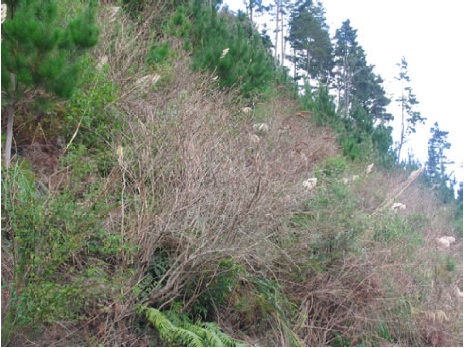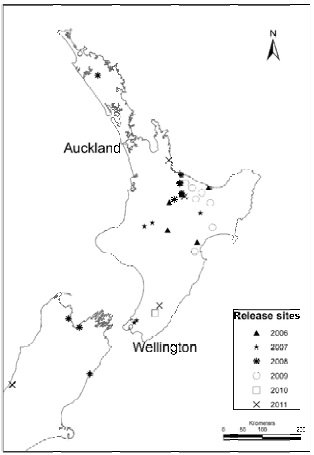PESTS AND DISEASES OF FORESTRY IN NEW ZEALAND
Buddleia biological control looking promising
Scion is the leading provider of forest-related knowledge in New Zealand
Formerly known as the Forest Research Institute, Scion has been a leader in research relating to forest health for over 50 years. The Rotorua-based Crown Research Institute continues to provide science that will protect all forests from damage caused by insect pests, pathogens and weeds. The information presented below arises from these research activities.
From Forest Health News No. 215, May 2011.

The buddleia leaf weevil, Cleopus japonicus, was first released in New Zealand by Scion in September 2006. After the first five large releases in North Island plantations (Whakarewarewa, Kinleith, Lake Taupo, Esk, and Rawhiti Forests) many smaller releases of the weevil were made around New Zealand. Each year these sites are checked by the landowners or managers for establishment and damage.
Approximately 40 releases of the weevil have been made. All those more than a year old have resulted in establishment, including a release of only 17 adults in Hawke’s Bay. The only possible exception to these successful results was the Upper Hutt release made in 2007.
This autumn we have had records of the weevil being found throughout the Bay of Plenty and adjacent areas. Spread from the original release sites has been impressive, with the weevil being found up to 50km from these release sites. This includes the Whakarewarewa Forest site in Rotorua, which seemed to perform poorly in the first three years after release.

This year we have seen a lot more damage to buddleia, with large areas of buddleia completely defoliated by the weevil. Observations indicate that the weevil is sensitive to microclimate variability. At warmer sites it has often shown a preference for gullies, whilst at cool sites the weevil preferentially attacks the buddleia in more open, sunny positions.
Once again, feeding damage increased rapidly from February onwards and peaked in April and May. As observed previously, there were no larvae during January and no mating adults were seen during this time. This non-egg laying period, when the weevils are relatively inactive, results in a period with very little additional damage to buddleia, but by mid-February huge numbers of larvae can be found. These larvae rapidly defoliate the buddleia. Newly emerged adults can be found searching for buddleia and flying en masse in April and May.
The buddleia leaf weevil has a tendency to over exhaust its resource in autumn so that many larvae run out of food and new adults can emerge with nothing to eat. This results in any new growth quickly being attacked and even tiny buddleia seedlings being eaten. The ability of adults to survive without food for extended periods combined with this high level of attack year after year should lead to a reduction in the growth of buddleia.
Scion is encouraging the further spread of the weevil to new areas. For further information on where and how to collect and redistribute it please contact Scion.
Michelle Watson
This information is intended for general interest only. It is not intended to be a substitute for specific specialist advice on any matter and should not be relied on for that purpose. Scion will not be liable for any direct, indirect, incidental, special, consequential or exemplary damages, loss of profits, or any other intangible losses that result from using the information provided on this site.
(Scion is the trading name of the New Zealand Forest Research Institute Limited.)

 Farm Forestry New Zealand
Farm Forestry New Zealand

